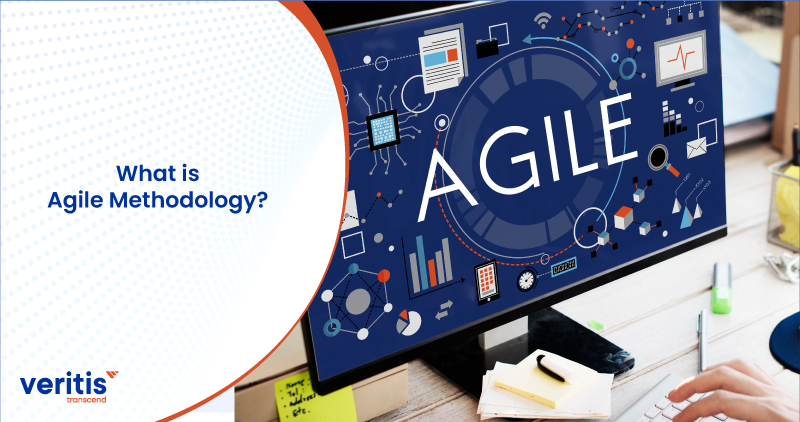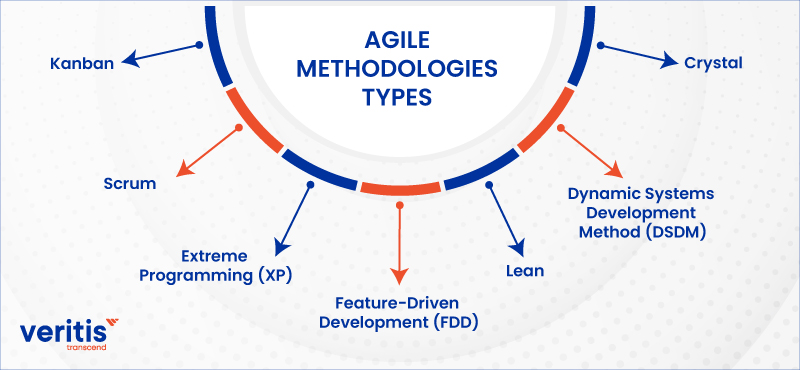
In the dynamic world of software development, agility has become a crucial aspect of successful project management. Agile methodologies have gained immense popularity for their ability to adapt to changing requirements. It includes promoting collaboration and delivering high-quality products efficiently.
There are various approaches that developers and stakeholders can use for software development. One of the most effective methods is the agile delivery model. It emphasizes continuous iteration in both the development and testing stages.
According to recent surveys, the adoption rate of agile methodologies has continued to increase steadily in 2023. It is estimated that over 80% of organizations worldwide have embraced agile approaches in some form, indicating a widespread recognition of their benefits in delivering successful projects.
Agile is a way for teams to work together on a project. It breaks the work into different stages and involves customers throughout the process. The team monitors progress at each stage. Unlike traditional methods, agile allows development and testing to happen simultaneously and stay in sync.
As we dive into 2023, we must explore the seven important types of agile methodologies that continue to shape the industry. Organizations worldwide have embraced these methodologies. It leads to highlighting their impact on project success rates and customer satisfaction. Before delving into these methodologies, let’s first know what agile methodology is and the principles of agile.
What is Agile Methodology?

Is agile a methodology? Before we answer that, let’s go back to the early days of agile.
Agile came into existence in 2001 with the release of the agile manifesto. This document introduced 4 important truths and 12 principles that significantly changed the software development world. Now let’s tackle the main question. What exactly is an agile methodology?
There are different opinions on whether agile is a methodology or not. Some believe it’s not just a methodology but a set of principles and beliefs, almost like a software development “philosophy” or “religion.” Implementing those principles through various agile events, traditions, and methods forms a different agile methodology.
Agile methodologies guide how to do things that align with the agile delivery model, values, and principles. They show you the steps and approaches to follow to work effectively in an agile manner.
Team collaboration is a fundamental value in agile implementation. When developing complex software, agile methodologies help us work together efficiently by guiding the best collaboration methods. The ultimate aim is to make customers happier with each software release.
Useful link: How Agile and IT Service Management can Work Together?
Agile Principles
12 important principles continue to shape agile program management practices.
1) Customer satisfaction is the top priority, and we achieve that by delivering results quickly and consistently.
2) They welcome changes in the environment at any point in the process to give the customer an edge over the competition.
3) Products or services are delivered more frequently.
4) Stakeholders and developers work closely every day, collaborating and communicating with each other regularly.
5) All stakeholders and team members stay motivated to achieve the best project results. Teams are given the tools, support, and trust they need to accomplish project goals.
6) Face-to-face meetings are considered the best way to ensure project success, as they are efficient and effective.
7) The ultimate measure of success is a completed and functional product.
8) Agile processes enable sustainable development by ensuring that development teams and stakeholders can maintain a steady and continuous pace.
9) Agility is improved by consistently prioritizing technical excellence and proper design.
10) Keeping things simple is crucial.
11) Teams that can organize themselves are more likely to create the best designs and meet requirements successfully.
12) Teams use regular intervals to improve efficiency by adjusting small behavior.
Agile Methodologies Types

Agile means organizing projects using the ideas and beliefs in the agile manifesto. There isn’t a single correct way for agile implementation, as various methodologies exist. Here are some of the most common types of agile methodologies.
1) Kanban
Kanban is an easy and visual project management method that allows teams to track progress and upcoming tasks. It uses a Kanban board with three columns: “To Do,” “Doing,” and “Done” to organize and manage tasks.
Kanban suits teams with tasks of varying sizes and frequently changing product requirements. However, it’s important to note that Kanban methodology is not as straightforward as Scrum. So, it may not be suitable for inexperienced agile teams.
Kanban is often recommended for smaller teams that work on repetitive tasks and can operate independently without relying heavily on others. It is a good option if your team values fast product delivery and understands agile best practices strongly.
2) Scrum
Scrum and Kanban have similarities in their approach. Scrum uses a Scrum board, similar to a Kanban board, to organize tasks based on progress. However, Scrum differs by breaking the agile program management software into sprints and managing them individually. Scrum also has specific roles like Scrum master and product owner.
Scrum is a versatile choice for teams of any size, whether experienced or new to agile implementation. It is especially suitable for teams who feel Scrum’s rigid rules limit productivity.
Scrum benefits teams working in fast-paced environments and handling multiple products simultaneously. It is a good fit for teams with more flexibility in estimating requirements from agile team management.
3) Extreme Programming (XP)
Extreme Programming (XP) is a methodology created for agile software development. It emphasizes continuous development and delivery to the customer. Like Scrum, it uses intervals or sprints. However, XP also has 12 specific processes designed for software development. These processes are tailored to ensure efficient and effective software development.
- Simple design
- Refactoring
- Pair programming
- Metaphor
- Collective code ownership
- Small releases
- Test-driven development
- Coding standards
- Planning game
- Sustainable pace
- Customer acceptance tests
- Continuous integration
XP suits teams with various skill levels, particularly when junior and senior programmers collaborate. It also benefits teams facing tight deadlines, limited budgets, and frequent changes in agile project management software requirements.
However, XP may not be the best choice for remote teams as it works best with small teams that are co-located in the same physical location.
4) Feature-Driven Development (FDD)
Feature-driven development (FDD) is related to agile frameworks specifically designed for software development. It involves creating software models every two weeks and requires a detailed development and design plan for each model feature. FDD has stricter documentation requirements than XP, making it suitable for teams with advanced design and planning skills. FDD breaks agile project management software down into five main activities.
- Build a feature list
- Design by feature
- Plan by feature
- Build by feature
- Develop an overall model
FDD agile method is useful for big software projects, especially in finance and banking. It helps speed up feature releases. However, it’s not suitable for smaller projects. Consider using it when your project becomes too complex for a regular Scrum team, especially in organizations where only software development teams follow agile tools.
Useful link: Waterfall Vs. Agile Vs. DevOps- Which Production Method Should You Take?
5) Lean
Lean development is often associated with the agile delivery model, but it’s a distinct methodology with similar values. The leading principles of Lean methodology such as:
- Respect people
- Defer commitment
- Deliver fast
- Optimize the whole
- Continuously acquire and expand knowledge
- Reducing waste
- Focus on ensuring high quality from the beginning
Reliable teams with expertise which can be trusted to make important decisions independently would find the Lean methodology highly beneficial.
The Lean methodology works best for smaller teams that work well together and can handle more detailed documentation. However, it may not be as suitable for larger teams or those that struggle with cohesion.
6) Dynamic Systems Development Method (DSDM)
The creators of the Dynamic Systems Development Method (DSDM) designed it to provide a standardized framework for fast software delivery. DSDM acknowledges that changes and rework are normal and emphasizes the importance of reversibility. Like Scrum, XP, and FDD, DSDM employs sprints or iterative cycles. This framework relies on eight key principles.
- Build incrementally from firm foundations
- Communicate continuously and clearly
- Focus on the business need
- Collaborate
- Deliver on time
- Demonstrate control
- Develop iteratively
- Never compromise quality
DSDM agile frameworks are suitable for small and large projects, including complex ones. It’s a good choice for teams comfortable with uncertainty and adapting to changing requirements.
DSDM is particularly effective in corporate settings, where implementing other agile tools can be challenging.
7) Crystal
Crystal is a group of agile tools with different versions like Crystal Clear, Crystal Yellow, Crystal Orange, and Crystal Red. Each version has its framework. Choosing which to use depends on team size, priorities, and project importance.
The Crystal project management process can be helpful for teams of different sizes. For instance, Crystal Clear is suitable for smaller teams and shorter projects with up to 6 developers, while Crystal Red works better for larger teams with up to 80 members.
Crystal is a good choice for teams that communicate often and work well together without constant supervision from agile team management. However, inexperienced agile teams may find Crystal methodologies challenging as they have less defined structures and some areas that may require interpretation.
Conclusion
Picking the right types of agile methodologies requires being flexible. Consider each option’s pros and cons to choose the best one for your business. Look for a framework that helps you create great digital experiences in a competitive market. Remember that the right agile approach attracts talented people to join your team.
Veritis, the Stevie Award for its outstanding DevOps services, is a popular choice for many businesses, ranging from small to large organizations, including Fortune 500 companies. We have a team of professionals who provide affordable solutions without compromising quality. Veritis is committed to staying updated with the latest advancements to ensure our services are future-proof. You can contact us if you have specific needs, and we will create a personalized solution tailored to your requirements.
Got Questions? Schedule A Call
Also Read:
- Cloud Native Applications: Understanding the Essentials
- Top 5 Tech Trends CIOs Must Focus on for 2023
- ‘All You Need to Know About Technology Business Management
- 12 Best Features for Work Management Software That Matter Most
- What Technologies Enable Digital Transformation?
- 10 Cloud Computing Trends Which Shall Dominate 2023